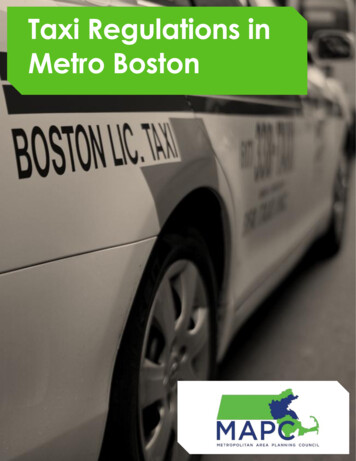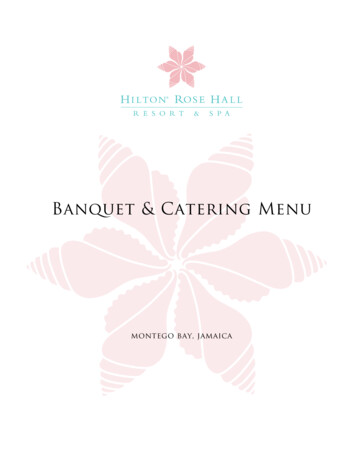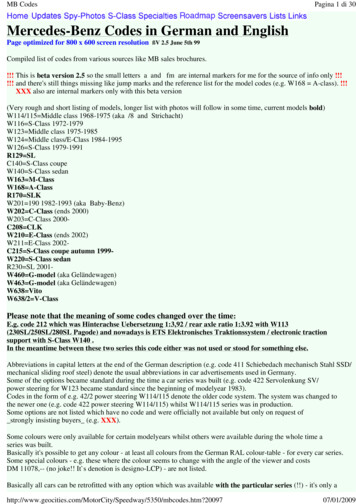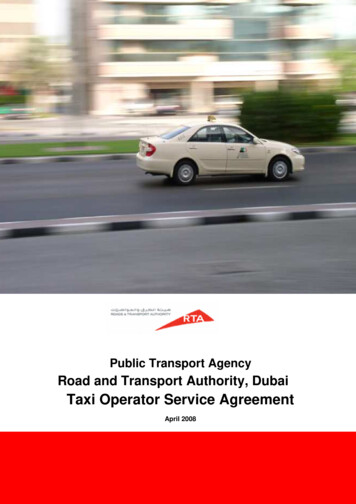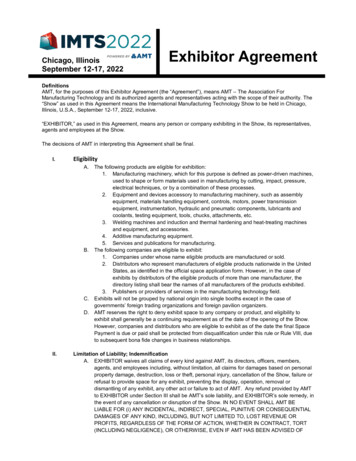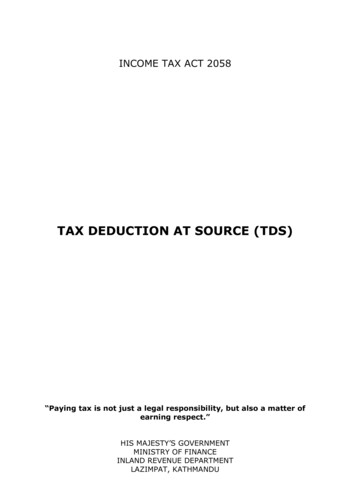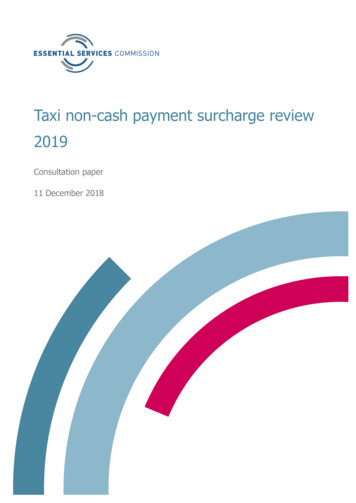
Transcription
Taxi non-cash payment surcharge review2019Consultation paper11 December 2018
An appropriate citation for this paper is:Essential Services Commission 2018, Taxi non-cash payment surcharge review 2019:Consultation paper, 11 DecemberCopyright notice Essential Services Commission, 2018This work, Taxi non-cash payment surcharge review 2019, is licensed under a Creative CommonsAttribution 4.0 licence [creativecommons.org/licenses/by/4.0]. You are free to re-use the workunder that licence, on the condition that you credit the Essential Services Commission as author,indicate if changes were made and comply with the other licence terms.The licence does not apply to any brand logo, images or photographs within the publication.Essential Services Commission Taxi non-cash payment surcharge review 2019i
Contents1. Summary1Our role is to assess the maximum non-cash payment surcharges in taxisWe are reviewing the maximum non-cash payment surchargeWe seek views on our methodology and approachThis is your opportunity to provide your views11332. What is a non-cash payment surcharge and who collects it?5The surcharge applies when using any payment method other than cashUsually taxi payment processors collect the surchargeWe will review the maximum surcharge taxi passengers pay5573. We will use reasonable cost to assess the non-cash payment surcharge8Our objectivesWe will assess the reasonable cost of serviceMethodologies for assessing reasonable costApproach to assessing reasonable cost8910114. Should there be a single maximum surcharge?13Payment terminals accept many different payment methodsThe cost of accepting and processing varies between payment methodsWe will examine whether the maximum surcharge should vary by payment method131314Appendix A: The non-cash payments supply chain16Non-cash payment systemsHow credit, debit and charge card transactions workNon-cash payment transactions in the taxi industryTaxi non-cash payment surcharging in other jurisdictions16172022Appendix B: Regulation of non-cash payment surcharging in other industries24Surcharging is allowed in AustraliaA surcharge must not exceed the average cost of acceptanceThe RBA’s guidance on surcharge ratesInterchange fees are also regulated by the RBA24252727Appendix C: Origin of the non-cash payment surcharge29The surcharge was first introduced for processing paper docketsThe taxi industry inquiry set the maximum surcharge at five per centOther states have followed Victoria’s example on the surcharge292930Appendix D: The legislation governing our role in setting the maximum non-cashpayment surchargeAppendix E: Records to be kept on non-cash payment surchargesGlossary314547ContentsEssential Services Commission Taxi non-cash payment surcharge review 2019ii
1. SummaryOur role is to assess the maximum non-cash payment surcharges in taxisIn 2012, the Taxi Industry Inquiry recommended that non-cash payment surcharges in taxis beregulated.1 These surcharges are fees charged to passengers, on top of the standard taxi fare, forpaying by any method other than cash. The Inquiry recommended that the maximum surcharge beset at five per cent. Prior to this recommendation it was industry standard to have a surcharge of10 per cent on non-cash payments. The Inquiry also recommended that we should review themaximum surcharge.In 2014, legislation came into effect setting the maximum non-cash payment surcharge (maximumsurcharge) at five per cent and giving us the power to determine the maximum surcharge.2Following recent reforms to commercial passenger vehicle industry legislation, we are nowrequired to determine the maximum surcharge for taxis by 2 July 2019.3We are reviewing the maximum non-cash payment surchargeThis consultation paper marks the start of our first review of the maximum surcharge. During thisreview we will establish our methodology and approach, which we will then use to determine themaximum surcharge. In determining the maximum surcharge our objective is to promote efficiency4and the long term interests of Victorian consumers5 while also allowing taxi payment processors torecover reasonable cost (see Box 1).6Box 1: Our objectivesUnder the Commercial Passenger Vehicle Industry Act 2017 (Vic) the objective of thecommission in relation to the non-cash payment transaction industry is to promote efficiencyby regulating the amount that may be imposed by way of a non-cash payment surcharge. Inseeking to achieve this objective, the commission must ensure that persons facilitating the1Taxi Industry Inquiry, Customers First: Service, Safety, Choice, Final Report, September 2012, p. 217.2Transport Legislation Amendment (Foundation Taxi and Hire Car Reforms) Act 2013.3Commercial Passenger Vehicle Industry Act 2017, s. 124.4Commercial Passenger Vehicle Industry Act 2017, s. 122.(1).5Essential Services Commission Act 2001, s. 8.6Commercial Passenger vehicle Industry Act 2017, s. 122(2).SummaryEssential Services Commission Taxi non-cash payment surcharge review 20191
making of non-cash payment transactions are able to recover the reasonable cost ofaccepting and processing such transactions.7Under the Essential Services Commission Act 2001 (Vic) the objective of the commission is topromote the long term interests of Victorian consumers. The commission must in seeking toachieve this objective have regard to the price, quality and reliability of essential services.8 Inaddition, the commission must have regard to a range of matters outlined in appendix D.This paper is intended to give stakeholders the information that they need in order to share theirviews on what issues we should consider while assessing the maximum surcharge. It is alsointended to give stakeholders an opportunity to comment on our understanding of the industry andthe approach we will take to reviewing the maximum surcharge.After submissions close on the consultation paper, we will release our draft decision on themaximum surcharge. This draft decision will give stakeholders the opportunity to comment on theanalysis underlying our draft decision. Following this, we will release our final decision with adetermination on the maximum surcharge. Table 1.1 gives an indicative timeline for the review.Our charter of consultation and regulatory practice has further information on the principles thatguide our approach to consultation.9Table 1.1: Indicative timelineActivityIndicative timelineRelease consultation paper11 December 2018Deadline for submissions on consultation paper4 February 2019Release draft decisionApril 2019Deadline for submissions on draft decisionMay 2019Release final report and price determination1 July 2019Price determination comes into effectSeptember 20197Commercial Passenger Vehicle Industry Act 2017 (Vic), s.122.8Essential Services Commission Act 2001 (Vic), s. 8.9ESC, Stakeholder Engagement Framework: Charter of Consultation and Regulatory Practice, 2018, available df (accessed on 22 November 2018).SummaryEssential Services Commission Taxi non-cash payment surcharge review 20192
We seek views on our methodology and approachIn setting the maximum surcharge we must ensure that it allows persons facilitating the making ofnon-cash payment transactions to recover ‘the reasonable cost of accepting and processing noncash payments’.10 We propose to use bottom-up cost assessments and benchmarking to assessreasonable costs.In a bottom-up cost assessment, regulated businesses submit detailed information on their costs tothe regulator. The regulator then determines the price required for the regulated business torecover its costs (including a market return on the business’ assets). A bottom-up cost review is arelatively data intensive method of assessing reasonable costs.Benchmarking methods use cost or price data available on comparable services to make findingson costs. For example, we could use information on the price of accepting and processing noncash payments in other industries to inform our determination on the maximum surcharge for taxis.We seek views on whether we should use these methods, or others, in assessing reasonable costsand on our proposed approach to applying these methods (see chapter three).This is your opportunity to provide your viewsWe want to hear your views on the maximum surcharge and our proposed approach to regulation.We encourage you to provide written submissions addressing the questions in this paper and anyother information relevant to the review. Submissions to this consultation paper are due by4 February 2019.Please email your submission to transport@esc.vic.gov.au. You may also send submissions viafax to 03 9032 1303 or by mail marked:Attention: Transport DivisionEssential Services CommissionLevel 37, 2 Lonsdale StreetMelbourne VIC 3000Publication of submissionsTo promote an open and transparent review process, we will make all submissions publiclyavailable on our website www.esc.vic.gov.au.10Commercial Passenger Vehicle Industry Act 2017, s. 122(2).SummaryEssential Services Commission Taxi non-cash payment surcharge review 20193
We treat all submissions as public information unless the submitter has asked us to treat some orall of a submission as confidential or commercially sensitive. Please clearly specify any informationthat you do not want to be made -submission-policySummaryEssential Services Commission Taxi non-cash payment surcharge review 20194
2. What is a non-cash payment surcharge and whocollects it?The surcharge applies when using any payment method other than cashA non-cash payment surcharge is “a fee or charge added to the amount otherwise payable by thehirer in respect of the hiring of a commercial passenger vehicle because the payment of theamount otherwise payable is made wholly or partly by means of a non-cash paymenttransaction”.12 As a result, the surcharge is applicable when paying for taxi services by credit card,debit card or charge card. It applies to all non-cash payment transactions for both booked andunbooked taxi services. Currently, taxis can apply a surcharge of up to a maximum of five per cent(including GST). This is an additional 1.40 on the average taxi fare of 28 in MetropolitanMelbourne.While the definition of the maximum surcharge in the Commercial Passenger Vehicle Industry Actrefers to all commercial passenger vehicles, we do not regulate non-cash payment surcharges forrideshare and hire car services.13 Rideshare and hire car surcharges are regulated by the ReserveBank of Australia (RBA) under the national payment systems framework.14Usually taxi payment processors collect the surchargeA non-cash payment surcharge may be collected by the taxi payment processor, booking serviceprovider, taxi driver or taxi owner. Who surcharges the passenger will vary depending on thepayment terminal used.Taxi payment processor surchargingThere are a large number of different taxi payment processing services that provide paymentterminals specifically designed for the taxi industry. These include Cabcharge, Cabfare, GM Cabs,Ingogo, Live Taxi and Smartpay. Although these services differ in their relationship with financialinstitutions, owners, drivers and payment schemes (such as Visa and MasterCard), for the purposeof our review we will call them taxi payment processors.12Commercial Passenger Vehicle Industry Act 2017, s.112(1).13Commercial Passenger Vehicle Industry Act 2017, s.112(2).14RBA 2016, Standard No. 3 of 2016: Scheme Rules Relating to Merchant Pricing for Credit, Debit and Prepaid CardTransactions, May.What is a non-cash payment surcharge and who collects itEssential Services Commission Taxi non-cash payment surcharge review 20195
Services provided by taxi payment processorsThe terminals provided by taxi payment processors can perform more functions than terminalsprovided by other payment processors (such as the big 4 banks, Tyro, or Square). These functionscan include integration with the taxi meter, integration with the taxi dispatch system, payment ofgovernment taxi subsidies, calculation of the non-cash payment surcharge and printing of taxinvoices with pick-up and drop-off locations.How taxi payment processors collect the surchargeTaxis mostly use terminals provided by taxi payment processors. These terminals pay the fare andsurcharge to the taxi payment processor. The surcharge is kept by the taxi payment processor andthe fare is transferred to the driver, operator, or booking network. Some taxi payment processorsalso transfer a share of the surcharge to drivers, owners, and/or networks.How taxi payment processors competeFor cards other than Cabcharge-branded cards, drivers can choose between different paymentprocessing options.15 Taxi payment processors therefore compete for drivers to steer payments totheir payment devices. As a result, taxi payment processors usually do not charge drivers foraccepting non-cash payments, but often provide different forms of incentives to attract more driversto use their payment terminals.16 Some taxi payment processors offer drivers other incentives suchas commission17, redeemable vouchers or gasoline discounts.18Booking service provider surchargingBooking service providers take booking requests from passengers and allocate jobs to drivers.Traditionally, bookings have been taken by telephone but increasingly passengers are bookingtaxis using smartphone applications.When a passenger books a taxi, in some cases the booking service provider will take payment forthe trip. This is most likely to occur when booking a taxi using an app. If the booking serviceprovider takes payment it may charge up to the maximum surcharge. We note that some bookingservice providers choose not to impose any surcharge.15Cabcharge-branded cards can only be processed by Cabcharge terminals and one other competitor. We understandanother party is interested to process Cabcharge-branded cards.16Taxi payment processors often charge a fixed fee if drivers do not process over a certain threshold each month.17https://www.ingogo.com.au/driver (accessed on 25 October 2018).18http://www.gmcabs.com.au/eftpos-solution/ (accessed on 25 October 2018).What is a non-cash payment surcharge and who collects itEssential Services Commission Taxi non-cash payment surcharge review 20196
Taxi driver surchargingIn a small number of cases, drivers use non-taxi payment terminals (for example Squareterminals). In this case, at the end of the trip, the driver manually adds the surcharge amount, of upto the maximum of five per cent, when inputting payment into the terminal. In this case both thefare and surcharge are deposited into the driver’s account (less any fees from their financialinstitution).We will review the maximum surcharge taxi passengers payRegardless of who charges the surcharge we will set the maximum amount that passengers pay.19The maximum surcharge we set will also apply to fees or charges payable by taxi drivers orowners to taxi payment processors because a fare has been paid by means of a non-cashpayment transaction.20Questions for stakeholders on our understanding of taxi non-cash payments1. As part of our review we have met with taxi drivers, taxi owners, taxi payment processors,booking service providers, CPVV, and Transport for Victoria. Our intention is to continue tomeet and work with stakeholders in our review of the maximum non-cash paymentsurcharge. Are there any other stakeholders in the taxi non-cash payment industry that weshould contact as part of our review?2. Is there any part of the supply chain that we appear to have misunderstood?19Commercial Passenger Vehicle Industry Act 2017, s.112(3)(a).20Commercial Passenger Vehicle Industry Act 2017, s.112(1)(b).What is a non-cash payment surcharge and who collects itEssential Services Commission Taxi non-cash payment surcharge review 20197
3. We will use reasonable cost to assess the non-cashpayment surchargeOur objectivesIn setting the maximum non-cash payment surcharge (maximum surcharge) our objectives are to: Promote efficiency in the non-cash payment transaction industry by regulating the amount thatmay be imposed by way of a non-cash payment surcharge. In seeking to achieve this objective,we must ensure that persons facilitating the making of non-cash payment transactions are ableto recover the reasonable cost of accepting and processing such transactions.21 Promote the long term interests of Victorian consumers. In seeking to achieve this objective wemust have regard to the price, quality and reliability of essential services.22We must also have regard to a range of other matters to the extent they are relevant: such as thefinancial viability of the industry and the degree and scope of competition.23 Additionally we mustadopt an approach and methodology which we consider will best meet the objectives set outabove.24Promoting efficiencyIn the context of the legislative objectives set out above, we propose to adopt a working definitionof efficiency in the non-cash payment transaction industry. For the purpose of this review weconsider that efficiency means: the right amount of non-cash payment services are provided to consumers (that is, there is noexcess demand or excess supply) there are the right incentives for investment and innovation by service providers and unnecessary costs are not incurred by customers when making non-cash payment transactions.To promote these outcomes the maximum surcharge should not be set too low or too high. If themaximum surcharge is set too low then taxi payment processors will not be able to recover their21Commercial Passenger Vehicle Industry Act 2017 (Vic) s. 122.22Essential Services Commission Act 2001 (Vic), s. 8.23Given that non-cash payment transactions are prescribed services, the maximum amounts of non-cash paymentsurcharges are prescribed prices and the non-cash payment transaction industry is a regulated industry for the purposesof the Essential Services Commission Act 2001 (Vic), we must also have regard to a number of other matters: EssentialServices Commission Act 2001 (Vic), s 8A and s 33(3) (see Appendix D).24Essential Services Commission Act 20019 (Vic), s33(2).We will use reasonable cost to assess the non-cash payment surchargeEssential Services Commission Taxi non-cash payment surcharge review 20198
costs, including a reasonable return on their investment. This could lead to under-investment inpayment processing services which could see passengers wanting to make non-cash payments fortaxi travel finding they are unable to do so (meaning there is excess or unmet demand for theseservices). On the other hand, if the maximum surcharge is set too high, customers will be payingmore than would otherwise be necessary. Further, it could lead to over-investment in paymentprocessing (excess supply) which might eventually be ‘stranded’ if the recoverable value of thesurcharge falls through regulation or competition.In other words, competition also has a role to play. Non-cash payment processing services areprovided by a number of competing taxi payment processors. If the regulated maximum surchargeis set too low, it may leave too little scope for robust competition between taxi payment processors(recalling that the commission only sets the maximum surcharge that service providers mayrecover from passengers). If the maximum surcharge is set too high and there is robustcompetition among service providers, then the surcharge might be expected to be bid below theregulated value as rivals seek to attract customers. However, as explained in appendix C, even ifthe surcharge imposed by payment processing providers is competed to a value below theregulated maximum, this does not mean that this benefit will flow through to passengers.As a result, understanding the cost of accepting and processing non-cash payment transactionswill be a key part of this review.Promoting the interests of Victorian consumersA maximum surcharge that promotes efficiency in the non-cash payment transaction industry willalso promote the long term interests of consumers. A surcharge that promotes the efficientprovision of services will provide the financial incentives taxi payment processors require to providean affordable service at the level of quality and reliability that consumers expect.We will assess the reasonable cost of serviceWe consider the term 'reasonable cost' to mean costs incurred in accepting and processing noncash payment transactions, which are moderate, not excessive, and within the limits of what itwould be rational or sensible to expect for the given level of service quality and reliability.The reasonable cost, upon which the maximum surcharge would be based, may differ to anyindividual firm’s actual costs. A firm incurring a cost does not, in itself, make a cost reasonable. Forexample, if a taxi payment processing firm incurred costs that were not required to accept andprocess non-cash payments, it would not be reasonable for them to expect to be able recoverthose costs from passengers making non-cash payments.We will use reasonable cost to assess the non-cash payment surchargeEssential Services Commission Taxi non-cash payment surcharge review 20199
The Commercial Passenger Vehicle Industry Act provides some guidance on the meaning ofreasonable cost for non-cash payment transactions, but does not give an exhaustive definition. 25We propose to use the RBA’s standard on merchant surcharging as a starting point to help usassess the reasonable cost of accepting and processing non-cash payments. The RBA isresponsible for regulating non-cash payment surcharges in all other industries except the taxiindustry.26 Under the RBA’s standard, a surcharge for a payment method must not exceedmerchants’ costs of acceptance: this is the average cost per transaction for that payment method.The cost of acceptance is set out in the RBA’s standard on merchant surcharging and includesbank fees and other costs paid to third parties for non-cash payment processing27 but excludesmerchants’ internal costs such as labour or electricity costs.28 More detail on the RBA’s standardcan be found in appendix B.In using the RBA’s standard we would also account for any additional non-cash payment servicesprovided by taxi payment processors by making an allowance for the reasonable costs of providingthose additional services.Methodologies for assessing reasonable costTwo methods regulators often use to assess costs are bottom-up cost assessment andbenchmarking.Bottom-up cost assessmentBottom-up cost assessments are commonly used to estimate costs by adding together theelements that make up a business’ costs. The costs that are usually included in bottom-up costassessments include: Operating costs (annual expenses) Depreciation costs (this accounts for the purchase price of assets) A return on capital (to give businesses an incentive to invest) Tax costs (an allowance for tax liabilities)25Reasonable cost includes any fees payable for the acquisition of transactions involving the use of debit, credit orcharge cards: Commercial Passenger Vehicle Industry Act 2017 (Vic), s 122(3).26RBA 2016, Standard No.3 of 2016: Scheme rules relating to merchant pricing, May, p.5.27RBA 2016, Standard no. 3 of 2016: Scheme rules relating to merchant pricing, May, pp.6-9.28RBA, aymentsregulation-qa-conclusions-paper.html (accessed on 15 October 2018); ACCC 2018, Payment surcharges: only chargewhat it costs you, January, p.2.We will use reasonable cost to assess the non-cash payment surchargeEssential Services Commission Taxi non-cash payment surcharge review 201910
Bottom-up cost assessments are generally quite data intensive. Businesses must submit detailedinformation on their past costs and how they expect these costs will change in the future. Theregulator must then assess the costs submitted by the regulated business.To minimise the cost of data collection we could base our bottom-up cost assessment on dataalready provided by taxi payment processors to regulators. For example, this could include data onoperations maintained in accordance with the Commercial Passenger Vehicle Industry Regulations2018 (Vic).29BenchmarkingBenchmarking uses information on prices or costs from comparable markets to determinereasonable costs.Benchmarking is a simpler way of assessing costs than bottom-up cost assessments. It is relativelyless data intensive. Instead of estimating costs by adding up a large number of cost categories,benchmarking creates an estimate using information already available for similar services.An obvious benchmark for non-cash payment processing in taxis is the costs of non-cash paymentprocessing in other retail markets. This is because the underlying cost of providing non-cashpayments should be quite similar. The technology in payment terminals is quite similar andinterchange fees for debit and credit payment systems are regulated.Although there are many similarities between the cost of accepting and processing non-cashpayments in taxis and the broader economy, we will need to take into account the differencesbetween the two. For example, we will need to consider differences in total transaction values.These will impact both merchant service fees and how the cost of payment terminals are amortisedacross transactions.30 We will also consider key differences, if any, in terms of services provided bytaxi payment processors and non-taxi payment processors.Approach to assessing reasonable costTo assess the reasonable cost of accepting and processing non-cash payments we propose to useboth bottom-up cost based assessment and benchmarking. Using two different methods willimprove the robustness of our decision. We will be able to use results from each method as acrosscheck of the results from the other method.29Commercial Passenger Vehicle Industry Regulations 2018, ml.We will use reasonable cost to assess the non-cash payment surchargeEssential Services Commission Taxi non-cash payment surcharge review 201911
In order to implement these methods we will request information from taxi payment processors ontheir costs following the release of this consultation paper. The method on which we place the mostweight when we make our determination on the maximum surcharge may depend on the quality ofthe data that we receive. In circumstances where regulated businesses provide limited usefulinformation on their costs, regulators sometimes place greater weight on benchmarking.Questions for stakeholders on our approach to assessing reasonable costs3. What evidence is there that the current five per cent maximum surcharge is lower than,higher than, or reflects ‘the reasonable cost’ of accepting and processing non-cashpayments?4. What sources of information should we consult when assessing reasonable costs?5. Are the costs of acceptance included in the RBA’s merchant surcharging standard reflectiveof the reasonable cost of processing non-cash payments for taxis? If not, which costsshould be included or excluded?6. What are the advantages and disadvantages of using bottom-up cost assessments for thereasonable cost of accepting and processing non-cash payments?7. What are the advantages and disadvantages of using benchmarking methods to assess thereasonable cost of accepting and processing non-cash payments?8. What differences in costs would need to be taken into account if benchmarking non-cashsurcharges from taxi payment processors and other payment terminal providers?9. What other methods could we use to assess the reasonable cost of accepting andprocessing non-cash payments?We will use reasonable cost to assess the non-cash payment surchargeEssential Services Commission Taxi non-cash payment surcharge review 201912
4. Should there be a single maximum surcharge?We are required to ensure that persons facilitating the making of non-cash payment transactionsare able to recover ‘the reasonable cost of accepting and processing non-cash paymenttransactions’.31 The use of singular terminology suggests that we are required to ensure that themaximum surcharge is enough to recover a single industry wide cost.Given that we are required to ensure the recovery of a single industry wide cost, we could set asingle amount for the maximum non-cash payment surcharge (maximum surcharge). However, wealso have the option of setting multiple maximum surcharges under the Commercial PassengerVehicle Industry Act and the Essential Services Commission Act. 32The most obvious reason why we might set a number of different maximum surcharges would bebecause some payment methods are more costly than others.Payment terminals accept many different payment methodsPassengers may choose to pay for their taxi fare using credit cards, debit cards or charge cards.Different terminals accept different payment methods but taxis commonly accept: American Express Cabcharge Diners club EFTPOS MasterCard Visa.The cost of accepting and processing varies between payment methodsPayment processors pay different fees to financial institutions depending on the type of card usedand whether payment is made online or in-taxi.Merchant service fees vary for different cardsFinancial institutions charge merchants different amounts for accepting different payment methods.For example, payment processors will tend to pay more for accepting American Express and31Commercial Passenger Vehicle Industry Act 2017 s. 122(2).32Commercial Passenger Vehicle Industry Act 2017 s. 124(1); Essential Services Commission Act 2001, s. 33(5).Should there be a single ma
The RBA's guidance on surcharge rates 27 Interchange fees are also regulated by the RBA 27 . owners, drivers and payment schemes (such as Visa and MasterCard), for the purpose of our review we will call them taxi payment processors. . 13 Commercial Passenger Vehicle Industry Act 2017, s.112(2). 14 RBA 2016, Standard No. 3 of 2016: Scheme .
